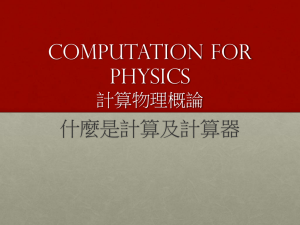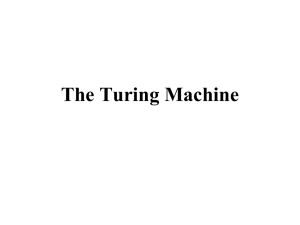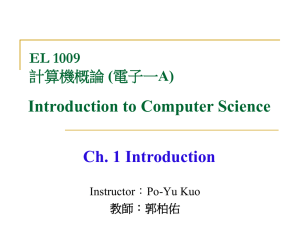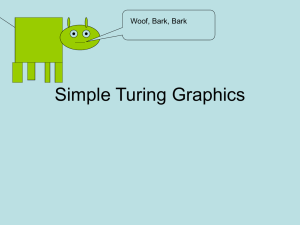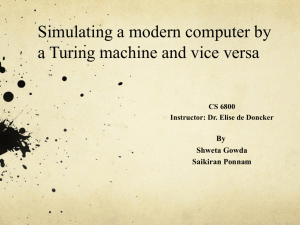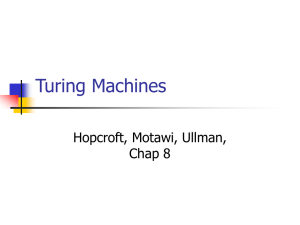COT 5405: Design and Analysis of Algorithms Instructor Mr. Arup
advertisement
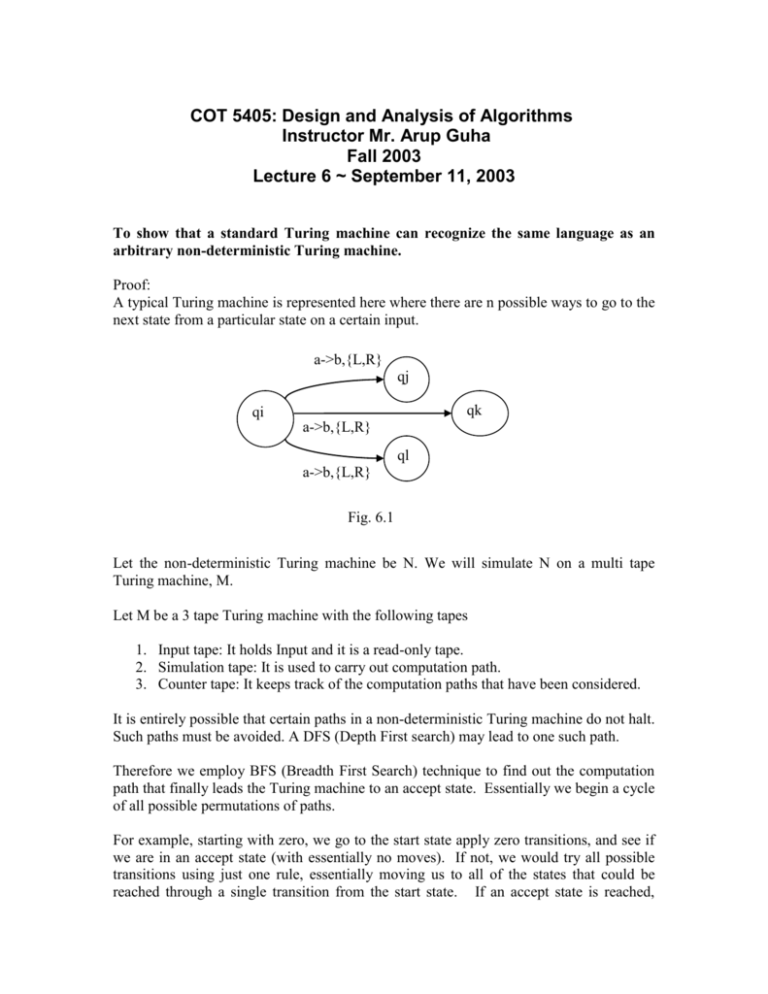
COT 5405: Design and Analysis of Algorithms
Instructor Mr. Arup Guha
Fall 2003
Lecture 6 ~ September 11, 2003
To show that a standard Turing machine can recognize the same language as an
arbitrary non-deterministic Turing machine.
Proof:
A typical Turing machine is represented here where there are n possible ways to go to the
next state from a particular state on a certain input.
a->b,{L,R}
qj
qk
qi
a->b,{L,R}
ql
a->b,{L,R}
Fig. 6.1
Let the non-deterministic Turing machine be N. We will simulate N on a multi tape
Turing machine, M.
Let M be a 3 tape Turing machine with the following tapes
1. Input tape: It holds Input and it is a read-only tape.
2. Simulation tape: It is used to carry out computation path.
3. Counter tape: It keeps track of the computation paths that have been considered.
It is entirely possible that certain paths in a non-deterministic Turing machine do not halt.
Such paths must be avoided. A DFS (Depth First search) may lead to one such path.
Therefore we employ BFS (Breadth First Search) technique to find out the computation
path that finally leads the Turing machine to an accept state. Essentially we begin a cycle
of all possible permutations of paths.
For example, starting with zero, we go to the start state apply zero transitions, and see if
we are in an accept state (with essentially no moves). If not, we would try all possible
transitions using just one rule, essentially moving us to all of the states that could be
reached through a single transition from the start state. If an accept state is reached,
accept; otherwise continue. Try all possible sets of two transitions from the start state,
and see if we reach an accept state. And so on.
Formally this is described as:
Assume that maximum number of transitions on any state for a certain input in the nondeterministic Turing machine is b.
The Turing machine runs in ‘Lexicographical order’ in the following manner
For Transition 1 (for each of the transition at the state at consideration on a certain input).
--------------------------------------1, 2, 3, 4… b
For Transition 2
----------------------------------------(1, 1), (1, 2), (1, 3)… (1, b)
(2, 1), (2, 2)…….….
Similarly
(b, 1), (b, 2) …
Similarly the path is computed for more transitions. Whenever any computation path is
traced that leads the Turing machine to an accept state, the machine halts. That path gives
the equivalent deterministic transition.
Since any language that is recognized by a multi tape Turing machine is also
recognizable by a standard Turing machine, an equivalent standard Turing machine can
be constructed.
Counter tape keeps track of the next transition to take place.
Simulation tape is used for running the transition.
Thus a deterministic Turing machine can be created from a non-deterministic Turing
machine that recognizes the same language.
Enumerator (For a language L)
Definition:
It is a special instance of the standard Turing machine and has the following properties.
1. It has a blank tape at start.
2. It prints out strings in a language L to the tape.
3. It does not pursue any particular order for printing out the strings to tape.
4. Strings may get repeated
5. Eventually an enumerator prints out all the strings in a language L on the tape.
e.g. enumerator for language L such that
L = { 0n1n / n >= 1}
01#000111#01#0011#.............
Where # is the separator between 2 strings
Turing recognizable languages are recursively enumerable iff there exists a Turing
machine that recognizes a language L and there exists an enumerator for L.
Proof:
First part:
To produce an enumeration E that enumerates the same language that a given Turing
machine recognizes do the following:
1. Input to M all inputs of length 1 and run each for 1 transition.
2. If any of these are accepted by M, output them to the tape.
3. Similarly carry out this process for inputs of length 2, 3….and run them for n
transitions. Whichever are accepted by M, output them to the tape.
4. Now the tape is nothing but the Enumeration of L.
(Note: this particular machine will generate many duplicates of certain words, which is
entirely acceptable by our definition of an enumerator. To avoid this, however, a larger
Enumerator could be constructed which contains the enumerator described above within
it and keeps 2 separate tapes listing the acceptable output of the internal enumerator and
its own output. The larger machine checks to see if any output from the enumerator has
been previously generated and only prints unique entries as its own output.)
Second part:
Given an enumerator E, construct a Turing machine that accepts the same language as
enumerator produces:
1. Let M be the Turing machine that takes some input. Run the enumerator. Every time
E gives out a string, M compares it with its original input. If they match, then M
accepts it. If it does not, then it lets M run.
2. Thus how a Turing machine that recognizes same language as the enumerator is
constructed.
Variations of standard Turing machine
Stay machine
Consider a different kind of Turing machine which can have a transition of the form
Q x Г= Q x Г x {L, R, S-Stay at the same place}
The variation of such standard Turing machine has the same power as the standard
Turing machine.
Proof:
To prove this let us construct a standard Turing machine that accepts the exact same
language as a stay machine S does.
Consider an arbitrary transition in S
(qi, a) -> (qj, b, S)
for each such transition which keeps the read-write head in the same position, create a
new state in standard Turing machine as qij such that following transitions are added to
the original Turing machine
(qi, a) -> (qij, b, R)
(qij, Г) -> (qj, Г, L) this represents all the transitions from state qij. No matter
what the input is it writes the same back to the tape goes to state qj and moves the head to
left.
XXXqi a XXXX
XXXqj b XXXX in stay machine, where X is any arbitrary character in Г.
XXXqi a XXXX
XXX b qij XXXX
XXXqj b XXXX in equivalent standard Turing machine.
This requires a single rule to move right and a series of rules to move left, one for each
possible character in Г.
Note: we need to chose a “more right, then move left” scheme to avoid “falling off” the
front of the input tape if we’re at the start position.
e.g. consider
(q1,0) -> (q3, 1, S) and Г ={b-blank,0,1,X}
which changes to
(q1, 0) -> (q13, 1, R)
(q13, b-blank) -> (q3, b-blank, L)
(q13, X) -> (q3, X, L)
(q13, 0) -> (q3, 0, L)
(q13, 1) -> (q3, 1, L)
b indicates blank
b->b, L
q13
0->1, R
0->0, L
1->1, L
q1
q3
X->X, L
Fig. 6.2
If there are two Stay rules for state qi to state qj, now we will require two transitions to
move from qi to qij and the same set of rules as before (one for each character in Г) to
move to state qj.
b indicates blank
1->2, R
b->b, L
q13
0->1, R
0->0, L
1/2->1/2, L
q1
q3
X->X, L
Fig. 6.3
